
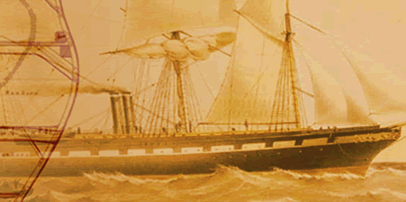
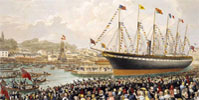
Launch of ss Great Britain
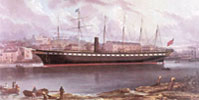
ss Great Britain sea trials
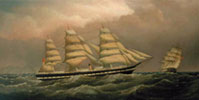
ss Great Britain off St Helena
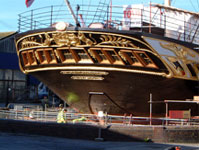
Newly gilded stern of ss Great Britain
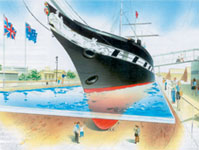
Artist’s impression of ss Great Britain’s
new ‘glass sea’
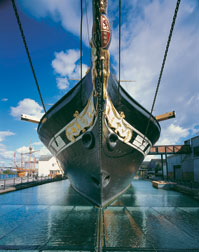
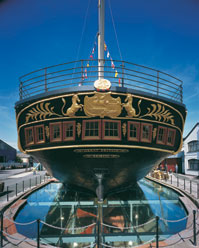
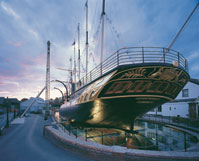
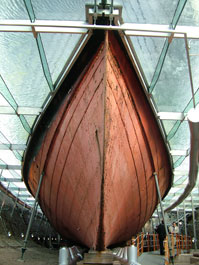
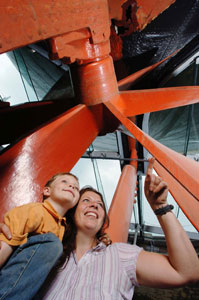
New photography by Mandy Reynolds. (All images above courtesy of ss
Great Britain Trust)


Brunel’s
friend Thomas Guppy, a Bristol engineer and business man who had been
instrumental in establishing the Great Western Railway, took the practical
step of bringing together the necessary partners to form the Great Western
Steamship Company with a view to making this happen (Guppy was also a
trustee of the Clifton Suspension Bridge and a valued colleague to Brunel).
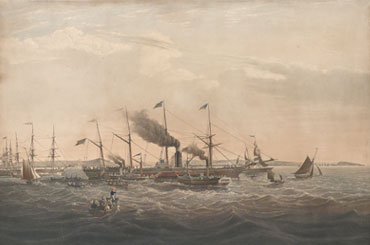
ss Great Western (Private collection)
Brunel’s first shipbuilding project for the new company was the
ss Great Western. The ship was built by the firm of William Patterson,
a leading Bristol shipbuilder, with steam engines provided by Maudslay,
Sons and Field in London. She was an oak-hulled paddle steamer and the
first steamship to provide a regular trans-Atlantic service, heralding
a new era of ocean going transport. The ship was launched in July 1837
from Wapping (now Prince’s) Wharf and moved to London for fitting
out. On her return trip to Bristol, fire broke out in the boiler room
and Brunel was injured when he fell 18 feet (5.49 metres) to the flooded
boiler room floor from a burning ladder. When the Great Western left Bristol
on 8 April 1838 for her maiden voyage to New York, 50 of her original
57 paying passengers had cancelled as they considered her too risky a
venture.
The Great Western Steamship Company’s main competitors in the race
to develop a trans-Atlantic steam line was British and American Steam
Navigation, a London-based group led by an expatriate American businessman
called Junius Smith. As a publicity stunt, Smith sent the Sirius, a channel
steamer, to cross the Atlantic in competition with the Great Western,
leaving Cork on April 4 1838.
The Great Western left Bristol on April 8 and arrived in New York 15 days
later, only 12 hours behind Sirius with 203 tons of coal to spare (a sailing
ship would have taken a month). In 1839, Bristol’s Royal Western
Hotel was opened to accommodate passengers stopping off en route between
the docks and Temple Meads station. However, the Great Western regular
service ran from Liverpool instead of Bristol. The hotel façade
is now part of Bristol City Council’s planning office, Brunel House.
Of perhaps greater significance for world travel was the Great Western’s
sister ship, the ss Great Britain launched on 19 July 1843, the largest
and most powerful ship to have been built to date and the first propeller
driven, steam powered iron ship to cross the Atlantic. Symptomatic of
the difficulties Bristol faced in its ambition to be a major port, the
Cumberland basin locks the ship needed to pass through in order to leave
the city proved to be too narrow. Brunel had to carry out widening work
and the ship remained in Bristol until 11 December 1844.
The ss Great Britain is the forerunner of modern passenger liners, making
regular voyages to the USA and Australia (it is estimated she carried
around 16,000 emigrants to Australia during her years of service). As
with the ss Great Western, after her launch, the ss Great Britain mainly
operated from Liverpool from where she made her maiden voyage to New York.
On 23 September 1846 she ran aground at Dundrum Bay in Ireland. Brunel
visited the site and wrote to his colleague Christopher Claxton:
I have returned from Dundrum with very mixed feelings of satisfaction
and pain, almost amounting to anger, with whom I don’t know. I was
delighted to find our fine ship almost as sound as the day she was launched,
and ten times stronger in character. I was grieved to see her lying unprotected,
deserted, and abandoned by all those who ought to know her value and ought
to have protected her. The result, whoever is to blame, is that the finest
ship in the world, in excellent condition such that £4,000 or £5,000
would repair all the damage done, has been left lying like a useless saucepan,
kicking about on the most exposed shore you can imagine, with no more
effort or skill applied to protect the property than the said saucepan
would have received on the beach at Brighton.
It took nearly a year to refloat her by which time the Great Western Steamship
Company was bankrupted. She was bought by Gibbs, Bright and Company.
At times of war ss Great Britain served as a troopship, travelling both
to the Crimea and to India. In later years, she was converted to a sailing
ship for carrying coal from Wales to San Francisco. Following storm damage
off Cape Horn in 1886, she struggled to the Falkland Islands where she
was used as a storage hulk for wood and coal. She was beached in Sparrow
Cove in 1937.
In 1970, the Great Britain was towed home to Bristol where now, partially
restored to her former glory, she is a major tourist attraction, dry docked
in the Great Western Dockyard that was originally created to build her.
She is probably rivalled only by the Clifton Suspension Bridge as a visual
image of the city’s splendour, and she makes an important contribution
to Bristol’s growing tourism and leisure economy. As a recipient
of lottery funding, the ss Great Britain site is undergoing further renewal
to enhance the visitor experience. Go to the ss
Great Britain website for more details of the history and restoration
of the ship.
